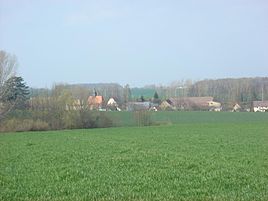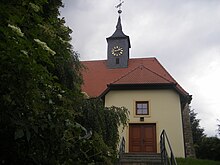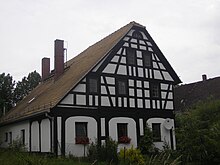Mohlis (Schmoelln)
|
Mohlis
City of Schmölln
Coordinates: 50 ° 55 ′ 10 ″ N , 12 ° 17 ′ 59 ″ E
|
||
|---|---|---|
| Height : | 266 m above sea level NHN | |
| Area : | 2.9 km² | |
| Residents : | 80 | |
| Population density : | 28 inhabitants / km² | |
| Incorporation : | July 1, 1950 | |
| Incorporated into: | Drugs | |
| Postal code : | 04626 | |
| Area code : | 034491 | |
|
Location of Mohlis in Thuringia |
||
|
View of the place
|
||
Mohlis is a district of the town of Schmölln in the Thuringian district of Altenburger Land . Until January 1, 2019, the place belonged to the Altenburger Land administrative community based in Mehna .
location
Mohlis is located in the Schmöllner-Altenburger Lösshügelland , a branch of the Leipzig lowland bay . The village is connected to the surrounding area via the county road 529. Federal road 7 passes further to the south-west near Schmölln . In Schmölln there is also a connection to the federal motorway 4 and the train.
Population development
Development of the population (December 31) :
|
|
- Data source: Thuringian State Office for Statistics
history
Mohlis belonged to the Wettin office of Altenburg , which was under the sovereignty of the following Ernestine duchies from the 16th century due to several divisions in the course of its existence : Duchy of Saxony (1554 to 1572), Duchy of Saxony-Weimar (1572 to 1603), Duchy of Saxony-Altenburg (1603 to 1672), Duchy of Saxony-Gotha-Altenburg (1672 to 1826). When the Ernestine duchies were reorganized in 1826, the place came back to the duchy of Saxony-Altenburg. After the administrative reform in the Duchy, Mohlis belonged to the Eastern District (until 1900) and to the Ronneburg District Office (from 1900). From 1918 the village belonged to the Free State of Saxony-Altenburg , which was added to the State of Thuringia in 1920. In 1922 it came to the district of Altenburg .
On July 1, 1950, Mohlis was incorporated after drugs. During the second district reform in the GDR in 1952, the existing states were dissolved and the districts were redesigned. Thus Mohlis came to the district of Leipzig as a district of drugs with the district of Schmölln ; that had belonged to Thuringia since 1990 as the district of Schmölln and became part of the district of Altenburger Land during the Thuringian district reform in 1994 . On January 1, 2019, the community of drugs was incorporated into Schmölln.
Economic history
Apart from the cities of Altenburg and Schmölln , mostly farming villages dominate, often with no more than 100 inhabitants, each dominated by one to three large goods , as well as smaller "hand goods" - houses that were formerly used by craftsmen or the servants of the local manors were inhabited. The stately manors indicate the early intensive agriculture in Altenburger Land . Fertile soils and the legal ban on dividing property in the Duchy of Saxony-Altenburg (later referred to as the so-called Reichserbhofgesetz, all German jurisdiction) promoted the growth of small farms into large four-sided farms with often villa-like houses. Even today, the non-division continues as an unwritten requirement in order to prevent the fragmentation of areas and small corridors that is common in southern Germany, for example. Field sizes of over 20 hectares are therefore normal, property areas of larger goods up to 70 hectares are common. With the dominance of the larger estates, the Altenburger Land has many long-established families (such as Kirmse, Misselwitz, Pohle, Gerth, Bubinger, newly added Sießmayr) who can now lovingly cultivate local customs and family traditions again.
An excellently reconstructed example is Gut Pohle in Mohlis, approx. 5 km from Schmölln. Erected in 1893 by the landlord Albin Pohle with the help of 50 Italian guest workers , it has four large buildings made of massive bricks, which enclose an inner courtyard of approx. 900 m². The house is designed as a slate-roofed villa with a flat gable roof on a floor area of 10 × 20 meters and has elaborate sandstone ornaments. All buildings have a full basement and are already prepared for machine installation. This made it possible to have a highly modern, partially mechanized and productive agriculture for the time, while in many places it was still operated by hand, by horse and cart without the use of running water or electricity. This generous form of the modern four-sided courtyard can often be found in the Altenburger Land , as productivity was further increased through investments up to the middle of the 20th century and old rural building methods disappeared. They were replaced with urban-bourgeois architectures.
The previous form with massive quarry stone walls and half-timbering with clay frames can be seen in the immediate vicinity of the residential building of the Baum estate, which was built in 1830. Today the goods are owned by the Bachmann and Pohle families. In 2016, extensive renovation work began on the Pohle estate. In this way, two large family estates typical of the region are preserved in a small area. The comparatively massive construction is also the reason for today's good state of preservation, despite years of neglect of the building fabric by the cooperatives in the years of the GDR . Another exemplary reconstructed building can be found in Göldschen , approx. 10 km west of Altenburg and in Lödla .
religion
The inhabitants of the place have been Protestants since the Reformation and belong to the Evangelical Church in Central Germany . Mohlis belongs to the parish Altkirchen , the responsible supture is Altenburg. Mohlis owns one of the oldest parish churches in Altenburger Land. The church was built in 1680 from field stones on the ground of the previous church and is designed as a single-nave church with a hipped roof and a small bell tower. It is located on a hill in the middle of the village. In the time of the GDR the house fell into neglect and became dilapidated, threatened to collapse until a few years ago because the building site had started moving.
From the beginning of the 1990s, due to the poor state of construction, there were no more church services, at that time four parishioners were visiting the nearby Altkirchen. With the active support of a specially founded church building association and numerous citizens of the place and the region, a renovation has been tackled since the year 2000, which has meanwhile made the church shine in new splendor. The renovation of the interior is currently underway after securing the subsoil prevented the collapse. In the future, the house is to be used primarily for cultural purposes, as the number of members of the community has decreased significantly.
Attractions
- Village church with surrounding church. The interior of the simple little church and the family graves in the cemetery are particularly worth seeing. They still tell of the prosperity and the proud peasantry of the Altenburg region .
- Half-timbered house in the town center. The building is embedded in a charming garden and gives authentic evidence of the typical construction of old farmhouses in Central Germany.
- Dimmer family home: an excellent example of an ecological and loving renovation of old buildings. The Dimmer family moved into the village and renovated an old half-timbered building using the clay construction method.
- Courtyard ensembles of the Pohle estates: large manor complex with listed, renovated residential buildings from the turn of the century and a well-preserved four-sided courtyard ensemble in its original state from the 19th century.
Mohlis is nestled in the fields and meadows of the Altenburger Land. Cycle paths lead via Graicha to Altenburg. The small town of Schmölln is 5 km away.
Infrastructure
The place Mohlis is located in the middle of intensively agricultural area. While four large estates farmed the land until the beginning of the forced collectivization of the von Mohlis peasants, the Pohle, (former Gerth) and Misselwitz estates in the village are now lessors, i.e. In other words , they let their land be cultivated by agricultural cooperatives or resettlers and are remunerated through annual rent. This means that only a few residents of the village practice an agricultural profession. Most of the workforce commute to nearby Schmölln or Altenburg and work there in industry or in the service economy.
Due to its central location between the growth centers of Jena, Leipzig and Chemnitz-Zwickau, the location is becoming increasingly interesting for young families. Nevertheless, an intimate, undisturbed country life is possible here. In addition, a large number of medium-sized industrial companies in Schmölln offer jobs. In recent years, the population has increased slightly and the average age has decreased considerably due to the comparatively high number of children in the village. As has always been the case, they go to school in Schmölln, 5 kilometers away. There are also several day-care centers with different orientations in neighboring communities , so that it is easier to combine family life, work and leisure time than in the nearby cities.
traffic
Mohlis can be easily reached from the federal motorway 4 via the Schmölln (5 km) and Beerwalde (7 km) junctions.
In Schmölln there is a connection to the Deutsche Bahn network :
- RE 1 on the central Germany connection Chemnitz - Göttingen and regional trains to Altenburg and Gera .
- S-Bahn network of the greater Leipzig area and the Central German Transport Association (MDV).
Web links
- "So that the church stays in the village" ( Memento from August 20, 2006 in the Internet Archive )
- Church building association Mohlis . In: Agricultural and cultural heritage database . Society for Agricultural History
Individual evidence
- ^ The Altenburg Office in the book "Geography for all Stands", from p. 201. Retrieved on April 1, 2020 .
- ↑ Adolf Stieler : The locations of the Altenburg office in "Geographical overview of the Saxon-Ernestine, Schwarzburg, Russian and adjacent lands", Gotha 1826, from p. 83. Retrieved on April 1, 2020 .
- ↑ The Eastern District of the Duchy of Saxony-Altenburg in the municipal register 1900. Retrieved on April 1, 2020 .
- ^ The Ronneburg District Office in the 1900 municipal register. Accessed April 1, 2020 .
- ↑ Mohlis on gov.genealogy.net



